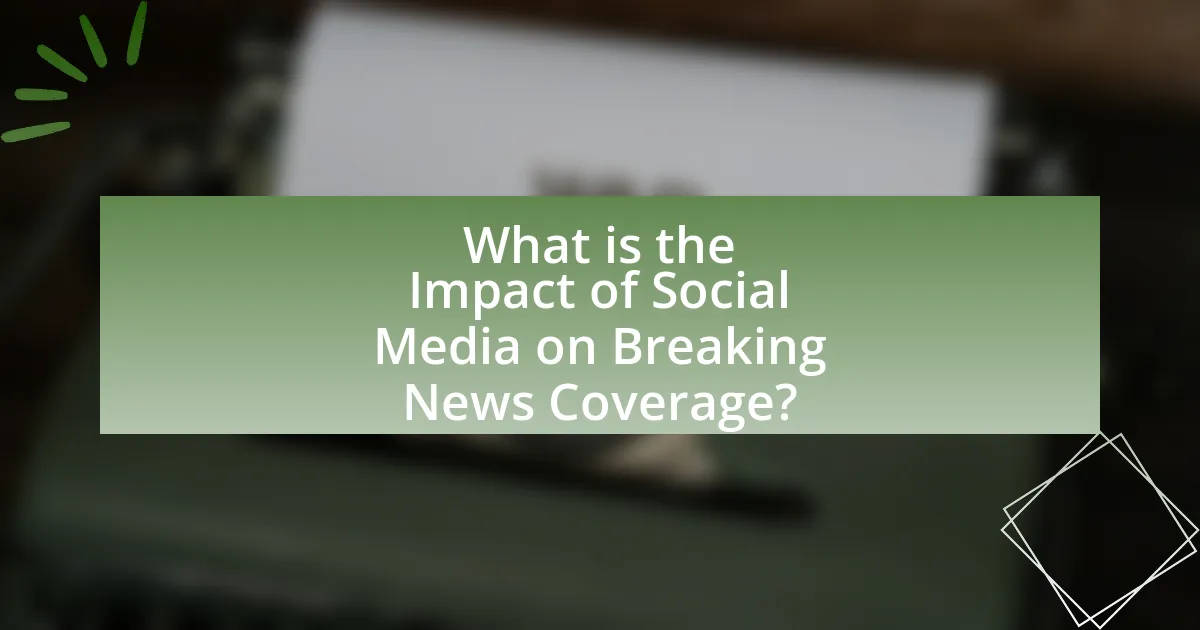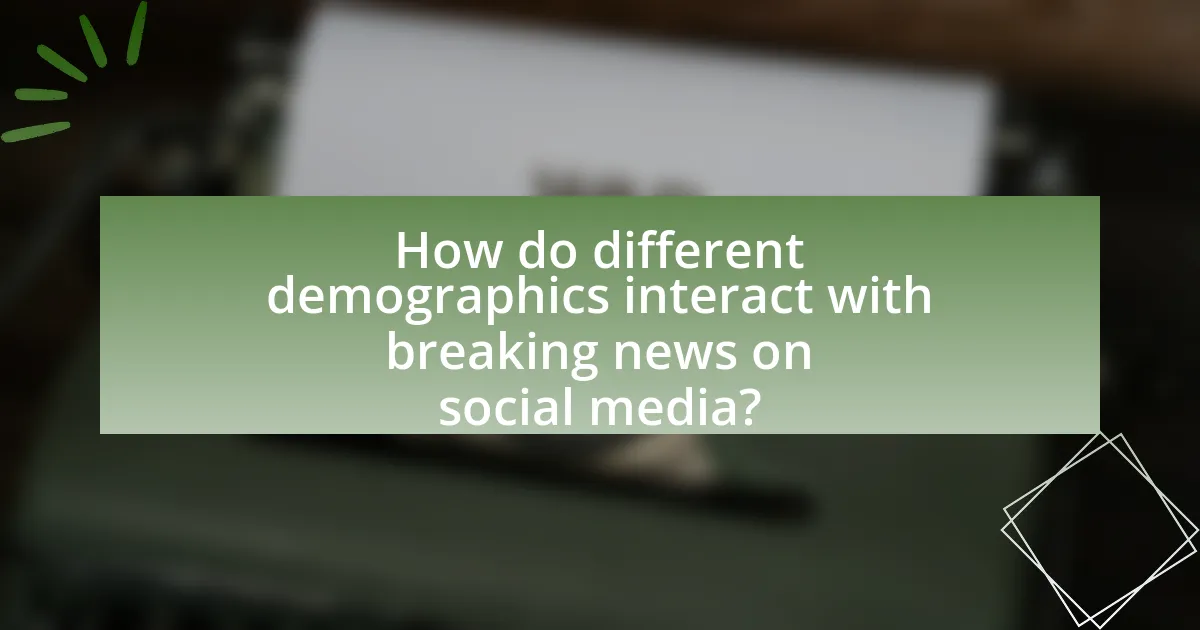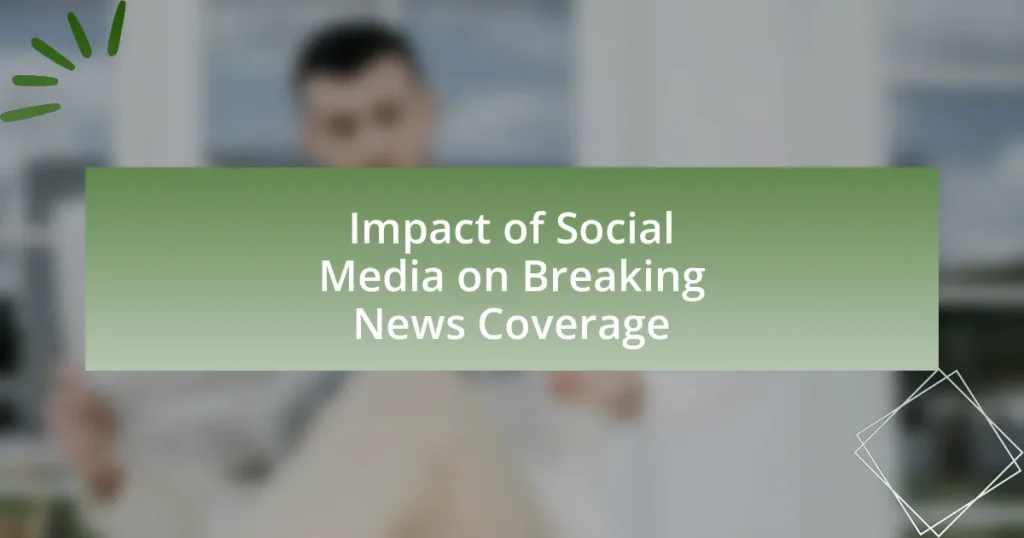The article examines the impact of social media on breaking news coverage, highlighting how platforms like Twitter and Facebook facilitate rapid information dissemination and audience engagement. It discusses the transformation of news reporting, the role of user-generated content, and the challenges posed by misinformation. Additionally, the article explores demographic differences in news consumption, the adaptation of traditional media to social media trends, and future developments in technology that will shape news reporting. Key findings include the significant reliance on social media for news among U.S. adults and the evolving strategies journalists must adopt to maintain credibility and engage audiences effectively.

What is the Impact of Social Media on Breaking News Coverage?
Social media significantly accelerates the dissemination of breaking news, allowing information to reach a global audience almost instantaneously. Platforms like Twitter and Facebook enable users to share updates in real-time, often before traditional news outlets can report on the events. For instance, during the Arab Spring in 2011, social media played a crucial role in spreading information about protests and government actions, demonstrating its power in shaping public awareness and response. Additionally, a Pew Research Center study found that 62% of adults in the U.S. get news from social media, highlighting its influence on news consumption habits. This rapid sharing can lead to both positive outcomes, such as increased awareness, and negative consequences, including the spread of misinformation.
How has social media changed the landscape of news reporting?
Social media has fundamentally transformed news reporting by enabling real-time dissemination of information and fostering direct engagement between journalists and audiences. This shift allows news to spread rapidly, often outpacing traditional media outlets; for instance, during the Arab Spring in 2011, platforms like Twitter and Facebook were pivotal in sharing updates and mobilizing protests, demonstrating their role as primary news sources. Furthermore, social media facilitates user-generated content, allowing individuals to report news events as they happen, which has led to a more democratized news landscape where diverse voices can contribute to the narrative.
What role do social media platforms play in disseminating breaking news?
Social media platforms serve as critical channels for disseminating breaking news by enabling real-time sharing and engagement among users. These platforms allow individuals and organizations to post updates instantly, reaching a global audience within seconds. For instance, during significant events like natural disasters or political uprisings, platforms such as Twitter and Facebook have been shown to facilitate rapid information flow, often outpacing traditional news outlets. A study by the Pew Research Center found that 62% of adults in the U.S. get news from social media, highlighting its role as a primary source of information. Furthermore, the interactive nature of social media allows users to share, comment, and discuss news stories, amplifying their reach and impact.
How do traditional media outlets adapt to the rise of social media?
Traditional media outlets adapt to the rise of social media by integrating digital platforms into their news distribution strategies. This adaptation includes creating social media accounts to share content, engaging with audiences in real-time, and utilizing analytics to understand viewer preferences. For instance, according to a Pew Research Center study, 62% of adults in the U.S. get news from social media, prompting traditional outlets to prioritize their online presence to reach these audiences effectively. Additionally, many traditional media organizations have developed multimedia content, such as videos and live streams, to enhance engagement and compete with the immediacy of social media reporting.
What are the advantages of using social media for breaking news coverage?
Social media offers rapid dissemination of breaking news, allowing information to reach a global audience almost instantaneously. This immediacy enables journalists and news organizations to share updates in real-time, facilitating timely reporting during critical events. According to a Pew Research Center study, 62% of adults in the U.S. get news from social media, highlighting its role as a primary news source. Additionally, social media platforms enable user-generated content, allowing eyewitnesses to share firsthand accounts and images, which can enhance the richness of news coverage. This participatory aspect fosters community engagement and can lead to a more comprehensive understanding of events as they unfold.
How does social media enhance the speed of news delivery?
Social media enhances the speed of news delivery by allowing real-time sharing and dissemination of information across vast networks. Platforms like Twitter and Facebook enable users to post updates instantly, which can be picked up by news organizations and shared widely within minutes. According to a Pew Research Center study, 62% of adults in the U.S. get news from social media, highlighting its role as a primary source for breaking news. This immediacy accelerates the news cycle, as events can be reported and updated in real-time, often before traditional media outlets can publish their stories.
What opportunities does social media provide for audience engagement?
Social media provides numerous opportunities for audience engagement, including real-time interaction, personalized content delivery, and community building. These platforms enable users to comment, share, and react instantly to news, fostering a dialogue between audiences and content creators. For instance, studies show that 64% of users prefer engaging with brands on social media rather than through traditional channels, highlighting the effectiveness of these platforms in facilitating direct communication. Additionally, social media algorithms allow for tailored content that resonates with individual preferences, enhancing user experience and engagement.
What challenges does social media pose to breaking news coverage?
Social media poses significant challenges to breaking news coverage by facilitating the rapid spread of misinformation. This misinformation can lead to confusion and panic among the public, as seen during events like the Boston Marathon bombing in 2013, where false reports circulated widely before verified information was available. Additionally, the pressure to be first in reporting can result in journalists sharing unverified information, compromising the accuracy of news coverage. The algorithms used by social media platforms often prioritize sensational content, which can overshadow important but less attention-grabbing news, further distorting public perception.
How does misinformation spread on social media during breaking news events?
Misinformation spreads on social media during breaking news events primarily through rapid sharing and engagement mechanisms. Users often share unverified information quickly, driven by emotional reactions and the urgency of the news, which leads to a viral effect. A study by the Massachusetts Institute of Technology found that false news stories are 70% more likely to be retweeted than true stories, highlighting the tendency for sensational content to gain traction. Additionally, algorithms on platforms prioritize engagement, amplifying misleading content further. This combination of user behavior and platform dynamics creates an environment where misinformation can proliferate rapidly during critical news moments.
What impact does the lack of editorial oversight have on news quality?
The lack of editorial oversight significantly diminishes news quality by allowing the dissemination of unverified information and increasing the likelihood of misinformation. Without editorial checks, news outlets may publish stories based on incomplete or inaccurate sources, leading to public confusion and distrust. For instance, a study by the Pew Research Center found that 64% of Americans believe fabricated news stories cause a great deal of confusion about the basic facts of current events. This lack of oversight can also result in sensationalism, where headlines are exaggerated to attract clicks, further compromising journalistic integrity.

How do different demographics interact with breaking news on social media?
Different demographics interact with breaking news on social media in varied ways, influenced by factors such as age, education, and cultural background. For instance, younger users, particularly those aged 18-29, are more likely to engage with breaking news through platforms like Twitter and Instagram, often sharing and commenting on posts, as evidenced by a Pew Research Center study which found that 62% of this age group gets news from social media. In contrast, older demographics, such as those aged 50 and above, tend to prefer Facebook for news consumption, focusing more on reading rather than sharing, with only 23% of this group actively sharing news content. Additionally, educational background affects engagement levels; individuals with higher education levels are more likely to seek out diverse news sources and critically evaluate the information presented. Cultural factors also play a role, as different ethnic groups may gravitate towards specific platforms that align with their community’s communication preferences. Overall, these demographic variations shape how breaking news is disseminated and discussed across social media channels.
What age groups are most active in sharing breaking news on social media?
Individuals aged 18 to 29 are the most active in sharing breaking news on social media. According to a Pew Research Center study conducted in 2021, 53% of adults in this age group reported using social media as a primary source for news, significantly higher than older demographics. Additionally, the same study indicated that younger users are more likely to engage with news content by sharing it, with 71% of 18 to 29-year-olds stating they often share news stories on platforms like Twitter and Facebook. This trend highlights the pivotal role of younger audiences in disseminating breaking news through social media channels.
How do younger audiences consume news differently from older generations?
Younger audiences consume news primarily through digital platforms, particularly social media, while older generations tend to rely on traditional media such as television and print. Research indicates that 62% of adults aged 18-29 get their news from social media, compared to only 24% of those aged 50 and older, highlighting a significant generational divide in news consumption habits. Additionally, younger audiences prefer bite-sized content, often favoring videos and infographics over lengthy articles, which contrasts with older generations who are more accustomed to in-depth reporting. This shift is further supported by a Pew Research Center study showing that younger individuals are more likely to engage with news through mobile devices, emphasizing the role of technology in shaping their news consumption.
What factors influence the sharing behavior of different demographic groups?
The sharing behavior of different demographic groups is influenced by factors such as age, cultural background, education level, and social norms. Younger individuals, particularly those aged 18-29, are more likely to share content on social media due to their familiarity with digital platforms and a tendency to seek social validation. Cultural background affects sharing behavior as individuals from collectivist cultures may prioritize community-oriented content, while those from individualistic cultures may focus on personal expression. Education level also plays a role; individuals with higher education are often more discerning about the content they share, leading to a preference for credible sources. Social norms within specific demographic groups can dictate what is considered acceptable or desirable to share, further shaping sharing behavior. Research indicates that these factors collectively impact how news is disseminated across social media platforms, influencing the reach and engagement of breaking news stories.
How does geographic location affect social media news consumption?
Geographic location significantly influences social media news consumption by determining access to information, cultural context, and local relevance. For instance, individuals in urban areas often have higher internet penetration and access to diverse news sources compared to those in rural regions, leading to different consumption patterns. A study by the Pew Research Center found that urban residents are more likely to use social media for news, with 73% reporting they get news from platforms like Facebook and Twitter, compared to 58% in rural areas. Additionally, local events and issues are more prominently featured in social media feeds for users in specific geographic locations, affecting the type of news consumed. This localized content can drive engagement and influence public opinion based on regional interests and concerns.
What trends are observed in urban versus rural news consumption on social media?
Urban news consumption on social media tends to be higher than rural news consumption, reflecting differences in access and engagement with digital platforms. Research indicates that urban residents are more likely to use social media for news updates, with 72% of urban users reporting frequent engagement compared to 54% in rural areas. Additionally, urban users often prefer platforms like Twitter and Instagram for real-time news, while rural users may rely more on Facebook and local news websites. This trend is supported by a Pew Research Center study, which highlights that urban populations have greater internet access and are more inclined to follow news through social media channels.
How do cultural differences shape the perception of breaking news on social media?
Cultural differences significantly shape the perception of breaking news on social media by influencing how individuals interpret, share, and react to information. For instance, collectivist cultures may prioritize community-oriented narratives and emotional responses, while individualistic cultures might focus on personal impact and factual accuracy. Research by the Pew Research Center indicates that cultural context affects trust in news sources, with varying levels of skepticism towards media based on cultural backgrounds. Additionally, language nuances and local customs can alter the framing of news stories, leading to different interpretations and engagement levels across diverse audiences.

What are the future trends in social media and breaking news coverage?
Future trends in social media and breaking news coverage include increased use of artificial intelligence for content curation and real-time fact-checking. As social media platforms evolve, they are likely to implement advanced algorithms that analyze user behavior and preferences, delivering personalized news feeds. Additionally, the rise of video content and live streaming will continue to dominate, as platforms like TikTok and Instagram prioritize short, engaging formats for news dissemination.
Moreover, the integration of augmented reality (AR) and virtual reality (VR) technologies will enhance storytelling, allowing users to experience news events in immersive ways. According to a 2023 Pew Research Center study, 53% of U.S. adults now get news from social media, indicating a shift in how audiences consume information. This trend underscores the necessity for news organizations to adapt their strategies to maintain credibility and engage users effectively in a rapidly changing digital landscape.
How is technology evolving to enhance breaking news coverage on social media?
Technology is evolving to enhance breaking news coverage on social media through advancements in real-time data analytics, artificial intelligence, and mobile reporting tools. Real-time data analytics allows news organizations to monitor social media trends and user-generated content, enabling them to identify breaking news stories as they unfold. Artificial intelligence algorithms analyze vast amounts of data to filter relevant information, prioritize news stories, and even generate automated reports, which increases the speed and accuracy of news dissemination. Mobile reporting tools empower journalists to capture and share news from the field instantly, utilizing high-quality video and live streaming capabilities. For instance, platforms like Twitter and Facebook have integrated features that allow users to broadcast live events, significantly increasing the immediacy of news coverage. These technological advancements collectively improve the efficiency and responsiveness of news reporting on social media, ensuring that audiences receive timely and relevant information.
What role will artificial intelligence play in news reporting on social media?
Artificial intelligence will significantly enhance news reporting on social media by automating content curation, improving fact-checking, and personalizing news delivery. AI algorithms can analyze vast amounts of data in real-time, allowing news organizations to quickly identify trending topics and relevant stories. For instance, tools like natural language processing can assess the credibility of sources and flag misinformation, which is crucial in the fast-paced environment of social media. According to a 2021 report by the Reuters Institute for the Study of Journalism, 60% of journalists believe AI will play a key role in improving the accuracy of news reporting. This integration of AI not only streamlines the reporting process but also helps maintain journalistic integrity in an era where misinformation can spread rapidly.
How might user-generated content shape the future of breaking news?
User-generated content will significantly shape the future of breaking news by providing real-time information and diverse perspectives. As social media platforms enable individuals to share firsthand accounts and multimedia content during unfolding events, traditional news outlets increasingly rely on this information to enhance their coverage. For instance, during the Arab Spring, citizen journalists used platforms like Twitter and Facebook to disseminate critical updates, which were later integrated into mainstream news reports, demonstrating the power of user-generated content in shaping narratives. This trend indicates that as technology evolves, the role of everyday individuals in news reporting will likely expand, leading to a more immediate and varied representation of breaking news events.
What best practices should journalists follow when using social media for breaking news?
Journalists should verify information before sharing it on social media for breaking news. This practice is essential to maintain credibility and prevent the spread of misinformation. According to a study by the Pew Research Center, 64% of Americans believe that social media has a significant role in the spread of false information. Additionally, journalists should provide context and updates as new information becomes available, ensuring that their audience receives accurate and timely news. Engaging with the audience through comments and direct messages can also enhance transparency and trust.
How can journalists verify information before sharing it on social media?
Journalists can verify information before sharing it on social media by cross-referencing multiple credible sources and utilizing fact-checking tools. This process involves checking the information against established news outlets, official statements, and expert opinions to ensure accuracy. For instance, the Poynter Institute emphasizes the importance of using fact-checking websites like Snopes or FactCheck.org, which provide verified information on various claims. Additionally, journalists should assess the credibility of the original source, looking for transparency in authorship and evidence of reliability. By adhering to these practices, journalists can significantly reduce the risk of disseminating false information on social media platforms.
What strategies can journalists use to engage audiences effectively on social media?
Journalists can engage audiences effectively on social media by utilizing interactive content, such as polls and Q&A sessions, to foster direct communication. This strategy encourages audience participation and creates a sense of community around the news. Additionally, sharing multimedia elements like videos and infographics enhances storytelling and captures attention more effectively than text alone. Research indicates that posts with images receive 94% more views than those without, highlighting the importance of visual content in engagement. Furthermore, journalists should leverage trending topics and hashtags to increase visibility and relevance, as timely content resonates more with audiences. By combining these strategies, journalists can create a dynamic and engaging social media presence that attracts and retains audience interest.




